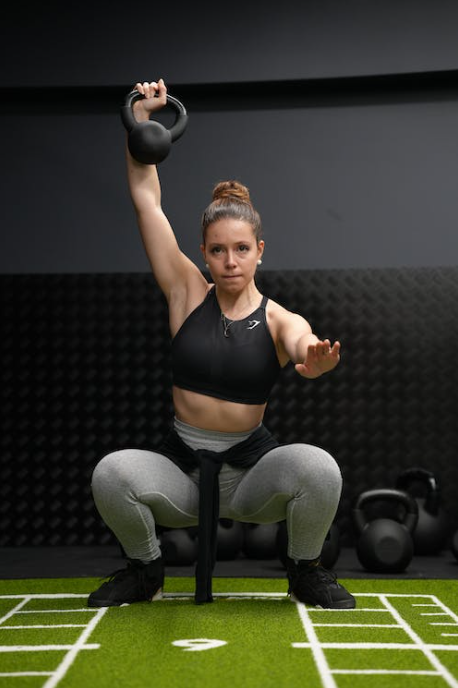Weightlifting is a form of exercise that’s extremely beneficial for everyone, especially women.
However, in order to start weightlifting, you need to know how to start a weightlifting routine.
There’s a lot that goes into starting a weightlifting routine. As well as a lot of things to consider. The best way to get started is to do some research beforehand.
Reading posts like this will help you understand the basics. However, the best way to learn is through experiencing it for yourself. This will help you decide what you like and don’t like.
Over time, you’ll find it easy to develop a weightlifting split that works for you and that you enjoy.
Let’s get into the five most important tips you need to start a weightlifting routine.
Why it’s important to have a weightlifting routine
It’s important you establish a routine for yourself to help keep your workouts organized and consistent.
A routine makes it much easier to track exactly what you should be training and when you should be training it. Which will allow for the most progress.
If you didn’t have a routine, you may get to the gym feeling confused and overwhelmed.
This is one of the main culprits of gym anxiety.
Arriving at the gym feeling lost and confused makes it difficult to make a plan on the spot. Especially when there’s so much going on around you.
Instead, arriving to the gym with a plan is one of the best ways to make consistent progress in the gym.
It helps keep you organized and is a great start to decrease gym anxiety.
Tips to help you start a weightlifting routine
1. Start out with basic exercises
When you’re first starting a weightlifting routine, it’s easy to get caught up in all the new confusing exercises out there.
But remember, there’s no need to overcomplicate things. The standard, simple exercises work extremely well.
I would suggest starting with simple, compound exercises. This will allow you to get the hang of things with exercises that work multiple muscle groups.
Additionally, because these exercises work multiple muscle groups, they’ll give you a much stronger foundation for more complicated exercises.
It’s especially important to start building a strong foundation if you’re someone who’s never lifted before.
Once you build at least some muscle, you’ll find it much easier to learn other, new exercises.
It’ll also be much easier to understand and learn proper form for your exercises.
This is because having muscle allows you to learn simply by feeling the way your muscles are engaged during an exercise.
It’d be much more difficult to do this without at least some muscle on your body.
That’s why it’s essential you start with basic, foundational exercises.
Some good exercises to start with are:
Squats
Lunges
Benching
Bicep curls
Tricep push downs
Shoulder press
All of these are great, not too complicated exercises to start developing some foundational muscle on your body.
2. Focus on your form

As a weightlifter, your form is extremely important.
I wrote a whole post on the importance of form when lifting weights.
If you don’t have good form when you’re working out, you put yourself at risk of injuries. As well as decrease your potential for progress.
Your body is designed to move a certain way, this way is optimal for training. However, if you begin moving your body incorrectly, you take muscles, joints, ligaments, and bones all out of alignment.
Additionally, if you’re not properly moving your body, you’re going to be taking much of the tension off of your muscle and placing it on surrounding areas.
When you do this, then add additional heavy weights or resistance, this will do one of two thing or both:
One) It’ll dramatically increase the risk of injury in those surrounding areas, or two) It will greatly decrease the amount of progress you can make from doing an exercise.
Both of these are things you really do not want to do when trying to make progress in the gym.
3. Create a weekly routine
By this, I don’t mean create a routine for one week then create a new routine for the next week.
Instead I mean create a routine that you’ll repeat each week. By this you’ll be dividing up the days of the week in order to make your routine.
Each day you will have dedicated to hit certain muscle groups and days dedicated to rest. This is what makes up your split, or gym routine.
Most likely, you should aim for hitting each muscle group one or two times a week. Any more than that usually doesn’t allow for enough rest and any less is usually not enough for you to see progress.
I like to hit the muscles I’m trying to grow more, two times a week. Whereas the muscles I’m trying to grow less or maintain, once a week.
To paint a better picture, I’ll show you my current workout routine.
One example of a week divided up to make a routine is:
Monday – Glutes and quads
Tuesday – Back and shoulders
Wednesday – Rest
Thursday – Calves and chest
Friday – Glutes, quads, and hammies
Saturday – Arms and shoulders
Sunday – Rest
As you can see, this routine prioritizes the growth of my glutes, quads, and shoulders.
This is an excellent example of one way that your gym routine might look.
4. Stay consistent
If you want to develop a workout routine that you love, you need to stay consistent in the gym.
Initially, you might not enjoy the exercises you’re doing, and that’s okay!
But it’s important to know that quitting won’t make these exercises any better. And it won’t help you discover exercises that you actually do enjoy.
You need to put work into the gym in order for it to become an enjoyable hobby and form of exercise.
Fall in love with the process of trying, failing, and finding new things.
If you keep showing up, your bound to find exercises that suit you and your goals. Ones that you want to include in your routine.
But you can’t do any of this if you don’t keep putting yourself out there and trying new things.
Keep in mind it’s important to show up and keep adding some variety to your routine.
5. Find exercises you enjoy for each muscle group

If you’re trying to stay consistent in the gym, it’s extremely important that you find exercises you enjoy.
Who wants to workout if they don’t like the exercises they’re doing?
So, to establish a workout routine that you enjoy, you’ll want to find exercises you enjoy for each muscle group.
To do this, you need to get into the gym and try out different exercises.
Sure, you can make a guess on what exercises you think you’ll enjoy. But only by trying them out and doing them yourself will you really know what works for you.
This tip is more to help you develop a routine you enjoy overtime. Not necessarily right from the beginning, as you most likely don’t know what you like and don’t like.
I recommend you pick 2 to 3 exercises for each muscle group that you thoroughly enjoy.
This helps give you options when deciding what you want to implement and when.
Then, you can implement these exercises into your routine on the days you want to train each muscle group.
Doing this ensures that each day you’re training, no matter what you’re hitting, you’re doing exercises you enjoy.
6. Your routine doesn’t need to be perfect
Going along with my last point, creating a perfect weightlifting routine just doesn’t exist.
There’s no way for you to know exactly what you like and don’t like until you try it out.
Because of this, you’ll continue to mix things up and try out different exercises to see what works for you.
This means your routine will constantly be changing depending on what exercises you chose to experiment with on which days.
You’re also going to be changing up your split every few months routinely. You do this to continue challenging your muscles once they adapt.
It’s important to note here that what worked for you one month might not work for you the next. You may no longer enjoy or want certain exercises in your routine again.
So don’t stress too much about trying to make a “perfect” routine before starting in the gym.
Really, no one’s routine is perfect and everyone’s is different.
The most important part is that you’re getting out there, lifting weights, and trying new things.
This is how you start becoming an experienced weightlifter.
What you can do now
Now that you’ve learned all these tips to help you start a routine, the best thing you can do is start applying them.
Use what you’ve learned here to develop a simple routine for yourself. One that you can keep changing and adapting to your preference.
Remember, there’s no such thing as a perfect weightlifting routine, it’s about doing whatever works best for you!
More posts on women’s weightlifting:
Weightlifting: your new favorite form of exercise